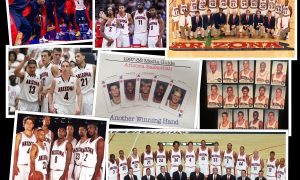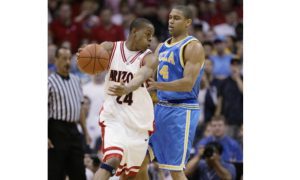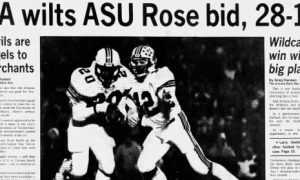|
|
|
ARIZONA PRODUCTIVITY RATING
[table “” not found /]
GLOSSARY:
G: Games played. S: Number of starts.
BP: Bench points. A player gets three points if he is first off the bench, two if second and one if third. Shows Sean Miller’s rotation.
SU: Productivity points against Stanford
SMIN: Minutes played against Stanford
PP: Productivity Points (Points, assists, rebounds, steals, blocked shots, FGs made, FTs made added together and then subtracted by missed FGs, missed FTs, personal fouls and turnovers)
TMIN: Minutes played overall
PR: Productivity rating per minute played (Productivity points divided by minutes played)
NOTE: Player must average at least 10 minutes a game to be listed in primary rotation
That’s clutch. That’s doing the right things to put yourself in a position to win. Arizona also plays three freshmen — Kaleb Tarczewski, Brandon Ashley and Grant Jerrett — extensively. They are talented but freshmen are always unpredictable. People lose sight of that.
Concerned: Miller would not have to be so concerned about putting the pieces together late in a game if the Wildcats played alert from the start. What’s with the slow starts? Not to sound like Bill Walton, but where is the plan on offense? Where is the focus? I researched this: Arizona is particularly unproductive in the first 10 minutes when they play Pac-12 teams at McKale Center. They have made only 28 of 81 field goal attempts — 34.6 percent — and 7 of 23 from three-point range — 30.4 percent — in the first 10 minutes at McKale against Stanford, USC, UCLA, Utah and Colorado. They trailed by double-digits in the first half to Stanford, UCLA and Colorado, and they were down 16-5 at Washington. That’s going to the well too many times.
Confident: The Wildcats have played 10 Pac-12 games. They are in first place, by the way. You have mentioned six of the 10 games, including one in which Arizona beat USC 74-50. They started out hot at Oregon but lost. They overwhelmed ASU, Oregon State and Washington State and all of those games were on the road. Welcome to college basketball as we know it today. I have not seen one team dominate every opponent they play from start to finish. Yes, Arizona has started slow against Stanford, UCLA, Colorado and Washington — and before that against Florida — but its record in those games is 4-1. I am sure Miller and the players are aware of their slow starts but they have made the necessary adjustments time and time again.
Concerned: Miller would agree that his team is putting itself in difficult situations with its turnovers. In Pac-12 games, the Wildcats have more turnovers (123) than assists (115). That is something we have not seen from Arizona since Lute Olson brought Steve Kerr to town.
Confident: True. A team that turns the ball over like that usually loses because it breaks down other facets of their game. But the Wildcats are out-shooting Pac-12 opponents from the floor and the free-throw line. They are out-rebounding opponents. They also have more steals and are outscoring opponents by an average of more than seven points (72.5 to 65.2). Again, I bring up the word resourceful. Can the Wildcats be better? Of course. The encouraging thing is Miller and the Wildcats take care of business and that’s what matters most to the NCAA tournament selection committee. They are 15-0 against teams that are worse than the Top 50 RPI. Miami, Syracuse, Florida, Louisville and Kansas can not say the same thing.
Concerned: Yeah, but they lost to two Pac-12 teams who are in the top 50 — Oregon and UCLA.
Confident: They also beat Colorado who is in the Top 50. Look, the refs looked at that monitor for five minutes. That call was made after much review. Also, they have beaten Miami, Florida, San Diego State and an 18-5 Southern Miss team. Next thing you’re going to tell me is Gabe York should play more minutes …
Concerned: Well …
Confident: Don’t even go there.
The most promising developments for Arizona in Thursday’s 73-66 victory over Stanford was Angelo Chol’s contribution off the bench (12 productivity points in 24 minutes) playing in place of injured Grant Jerrett and Mark Lyons’ resurgence as a productive leader at point guard.
Lyons posted 41 productivity points (25 points on 9-of-13 shooting from the field, six assists, two steals) in 36 minutes. That tops Brandon Ashley’s 40 productivity points against Long Beach State for the most by an Arizona player this season.
Lyons has 63 productivity points in 59 minutes in the last two wins over Washington State and Stanford.
Stanford’s Dwight Powell and Josh Huestis pulled down 20 of the Cardinal’s 33 rebounds. The Wildcats won the battle of the boards 37-33 after getting out-rebounded in two of their last four games.
Defensive Rebounding Percentage (DRB%): Determined by dividing Arizona’s defensive rebounds (26 against Stanford) by the opposition’s offensive rebounds (Stanford had 10) added to Arizona’s defensive rebounds (26) — 26/(10 + 26) = 72.2 percent.
Offensive Rebounding Percentage (ORB%): Determined by taking Arizona’s offensive rebound total (11) divided by that total (11) and the defensive rebounds of the opponent (23 for Stanford) — 11/(11+23) = 32.4 percent.
Ideal marks are 72 percent DRB% and 38 percent ORB%.
|
DEFENSIVE/OFFENSIVE REBOUNDING% [table “” not found /] |
Site publisher, writer and editor Javier Morales is a former Arizona Press Club award winner
[rps-paypal]
|
|































